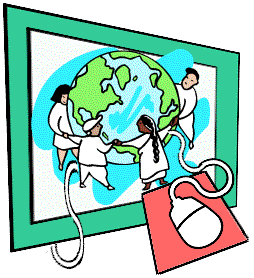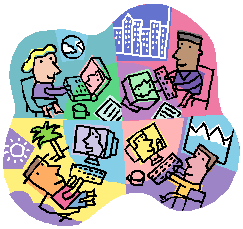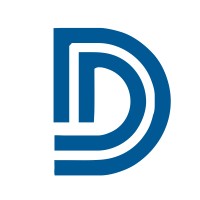Math Topics
Learning Support
Professional
![]()


Project-based learning is a terrific way to link your curriculum with real world events and applications of concepts that your students are learning. There are two pages in this section to help you and your learners.
Project Based Learning (Page 1): An essay about project based learning, which includes key questions and the methodology, how to design your own curriculum-based multimedia projects and WebQuests, and how to assess projects, including those involving multimedia. Additional resources are included to help learners understand the beauty of math in nature.
![]() Projects
on the Web (Page 2): Below is our list of K-12 math projects.
Projects
on the Web (Page 2): Below is our list of K-12 math projects.
Also see Technology Integration Resources for Multimedia in Projects, a three part collection with an essay on multimedia and resources for their use.
![]()
If you wish to become involved with project-based learning, it might be easier to start by participating in one or adapting one to your setting that has been designed by others.
REALLY HOT: Bridges Inspire your students to be creative in a project connecting art to mathematics. Visit the Bridges Galleries where you will find numerous mathematical art exhibits, photos, and a virtual museum with creations (e.g., paintings, drawings, sculptures, spherical art, origami, prints, textiles) by mathematicians and artists who are mathematically inclined.

HOT: The Futures Channel contains videos that link math and science to real world applications and careers. For example, the section on Teaching & Learning contains Algebra in the Real World (by topics covered within a typical algebra course), Hands on Math (by strands), Problem Solving (by strategies), and more. Each video is accompanied by a lesson that delves into the video's content. Best of all, videos and classroom activities are free.
See the YouTube videos on Using Parabolas in Real Life.
HOT: Math teacher Thomas Petra has a terrific site, Real World Math, which integrates Google Earth and SketchUp into the math curriculum. Within this site you will find lesson ideas, examples, and downloads for mathematics that embrace active learning and constructivism. You'll find lesson downloads on concept lessons, measurement, project-based learning, exploratory lessons and space lessons. The focus is for grades 4 and up, but teachers of younger students may be able to find some uses or inspiration from the site. Higher level thinking skills, such as analysis, synthesis, and creativity are encouraged as well as technology skills and social learning. The core of this site is mathematics, but many lessons lend themselves to interdisciplinary activities also. There are videos and Google Earth tutorials, Xtranormal tutorials, and HTML layout tutorials. A special section for teachers includes a blog.
Calvert Learning, a product of Edmentum, provides a project-based virtual and blended learning curriculum for K-5 learners, including for math. Per its description, "Projects are embedded throughout Calvert courses to give students opportunities to apply what they have learned to real-world situtations and develop creative problem-solving skills. Students kick off the unit with a project and revisit it as they learn new skills." Content is aligned to the Common Core and NGSS.
CAMS (California Academy of Math and Science) Inventors Inc.: The Successful Investor Project "is designed to give high school seniors firsthand knowledge of the world of entrepreneurship. The project can encompass one full academic semester or an entire year, and it is broken down into five sections:
Questions on investments, and an individual investment portfolio
Entrepreneurship time (developing a business plan to market a product)
Time to invest (stock market research, selection, and tracking
The convention (a business convention where students display their business plan and product, with marketing and advertising)
Wrapping up the project (debriefing)" (Overview section)

CIMS (Center for Industrial Mathematics and Science): Industrial Mathematics Projects for High School Students were developed by the Worcester Polytechnic Institute. The database includes "over 20 industrial mathematics projects for high school students drawn from a variety of real-world situations. Projects are available for every level of high school mathematics, from Algebra to Calculus and Statistics. The length and scope of the projects are very flexible – a project often contains enough material for a major, semester-long endeavor, but its component parts can also be used as brief enrichment activities" (Database description section). Projects are downloadable for immediate use.
 Deep Math Projects
by Jerry Burkhart at 5280math.com "are
open-ended projects that you can extend by continuing to ask new questions. The
problems often have multiple solutions and/or solution paths. The activities are
self-differentiating. Students may enter and exit them at points that suit their
level of understanding. The grade levels are approximate suggestions, because
students can think of the problems and questions on many levels" (Description
section). Listed projects are suggested for elementary grades.
Burkhart also has Deep
Algebra Projects designed for pre-algebra, algebra 1, and algebra 2.
Deep Math Projects
by Jerry Burkhart at 5280math.com "are
open-ended projects that you can extend by continuing to ask new questions. The
problems often have multiple solutions and/or solution paths. The activities are
self-differentiating. Students may enter and exit them at points that suit their
level of understanding. The grade levels are approximate suggestions, because
students can think of the problems and questions on many levels" (Description
section). Listed projects are suggested for elementary grades.
Burkhart also has Deep
Algebra Projects designed for pre-algebra, algebra 1, and algebra 2.
 Defined Learning is a subscription service that
provides project based learning, authentic performance tasks and non-fiction literacy tasks for Grades
K-12 in math, science, ELA and social studies. Each cross-curricular task
presents students with a real-world situation in a STEM career. The performance
tasks follow the Understanding by Design Framework. Students complete the task using the
G.R.A.S.P model in which the teacher presents the goal or big idea, then
students are given their role and told who the audience is and the situtation
they must solve. Ultimately they create a product (e.g. brochure,
commercial, model)that solves the problem. There are also constructed responses
geared toward students in K-6. A real-world video sets the stage for each lesson.
Tasks are aligned to state and national standards including Common Core and C3. Rubrics are
provided to help grade student work. A free trial is available.
Defined Learning is a subscription service that
provides project based learning, authentic performance tasks and non-fiction literacy tasks for Grades
K-12 in math, science, ELA and social studies. Each cross-curricular task
presents students with a real-world situation in a STEM career. The performance
tasks follow the Understanding by Design Framework. Students complete the task using the
G.R.A.S.P model in which the teacher presents the goal or big idea, then
students are given their role and told who the audience is and the situtation
they must solve. Ultimately they create a product (e.g. brochure,
commercial, model)that solves the problem. There are also constructed responses
geared toward students in K-6. A real-world video sets the stage for each lesson.
Tasks are aligned to state and national standards including Common Core and C3. Rubrics are
provided to help grade student work. A free trial is available.
 Discomath provides math investigations, mini-lessons and
math tools for teachers and students. Investigations are designed on the
project-based learning model. Mini-Lessons are one-off activities
created through the Desmos teacher's portal. Math Tools is a list
interactive graphs which allow deeper understanding of mathematical
concepts. Discomath contains mostly free resources. Investigations are behind
a registration pay wall ($20). This site is a project of David Zelenka of
Interactive Earth.
Discomath provides math investigations, mini-lessons and
math tools for teachers and students. Investigations are designed on the
project-based learning model. Mini-Lessons are one-off activities
created through the Desmos teacher's portal. Math Tools is a list
interactive graphs which allow deeper understanding of mathematical
concepts. Discomath contains mostly free resources. Investigations are behind
a registration pay wall ($20). This site is a project of David Zelenka of
Interactive Earth.
Global SchoolNet's Projects Registry includes more than 2,500 annotated listings of teacher-led global projects. It is searchable by date, age level, geographic location, collaboration type, technology tools used, or keyword. Narrow your search also by curriculum area. Join an existing project or announce one of your own. The database has several hundred projects addressing math.
 GLOBE (Global Learning and Observations to
Benefit the Environment) is a worldwide hands-on, primary and secondary
school-based science and education program. Students use the scientific
method to create hypotheses, analyze data, draw conclusions and report their
results through the Internet. They take scientifically valid measurements
in the fields of atmosphere, hydrology, soils, and land cover/phenology -
depending upon local curricula. GLOBE trains teachers to help students
improve their achievement in science and math, and in the use of computer and
network technology.
GLOBE (Global Learning and Observations to
Benefit the Environment) is a worldwide hands-on, primary and secondary
school-based science and education program. Students use the scientific
method to create hypotheses, analyze data, draw conclusions and report their
results through the Internet. They take scientifically valid measurements
in the fields of atmosphere, hydrology, soils, and land cover/phenology -
depending upon local curricula. GLOBE trains teachers to help students
improve their achievement in science and math, and in the use of computer and
network technology.
Hands-On Math Projects, Volume 2, by Carolyn S. Carter with Sara Cohen, Marian Keyes, Patricia S. Kusimo, and Crystal Lunsford (2002), contains two chapters devoted to "Projects That Help Middle-School-Age Youth Discover the Science and Mathematics in Everyday Life." The Mathematics of Quilting exposes learners to plane geometry, symmetry, and tessellations. In Making Art through Mathematics, learners explore Cartesian coordinates, 2-D and 3-D geometry, measurement, symmetry, and volume. This is a pdf document.
iEARN (International Education and Resource Network) "enables young people to use the Internet and other new technologies to engage in collaborative educational projects that both enhance learning and make a difference in the world." Math projects, for example, include Mathematics and Agriculture (ages 10+), Connecting Math to Our Lives (all ages), and Mathematics Virtual Learning Circle (all ages). iEARN offers both face-to-face and online professional development workshops and courses for educators seeking to integrate online global project work into their classrooms. Workshops include the technical, collaborative and organizational skills needed to participate.
Mathematics Classroom Examples at the Galileo Educational Network Association and Mt. Royal College in Calgary, Alberta, Canada include a number of inquiry-based activities with special sections devoted to Math Fairs, Math Investigations, and primary, middle, and high school project investigations. You can search by grade level, subject area, and language.
Math Explorers' Club from Cornell University is a National Science Foundation "supported project that develops materials and activites to give middle school and high school students an experience of more advanced topics in mathematics. ... Each module teaches material associated with a particular theme and is aimed at students with a particular level of mathematical sophistication."
Models of Excellence, an initiative of Expeditionary Learning in collaboration with the Harvard Graduate School of Education, is "a curated, open-source collection of models of high-quality PreK-12 student work, along with resources to support the use of exemplary student work to inspire and elevate teaching and learning" (FAQ section). You'll find many examples of math projects and projects related to other subjects, and resources that can be filtered by topics, such as planning, critique and revision, standards, differentiation, mindsets, assessment, and more.
PBLWorks: Projects from the Buck Institute for Education includes a database of projects in multiple subjects, including for math. You can search by subject area, grade level, standards including the Common Core. PBLWorks additional resources include articles, blogs, videos, planning tools, rubrics, and student handouts.
Science Buddies has numerous project ideas categorized within different areas of science. Among those are over 100 math projects of varying levels of difficulty.

David Warlick of Landmarks for Schools reminded teachers and students to seek permission when using information from web sites designed by others. He fprovided a simple to use Permission Template for this purpose, which will automatically go to the author or web master of the site you wish to use in instruction or for a school project.
Consider having your students create their own digital storybooks to display projects.
![]()
Back to top | Math Projects: Page 1 | 2
![]() Learn
about the technical side of creating multimedia projects, including
working with images and video.
Learn
about the technical side of creating multimedia projects, including
working with images and video.